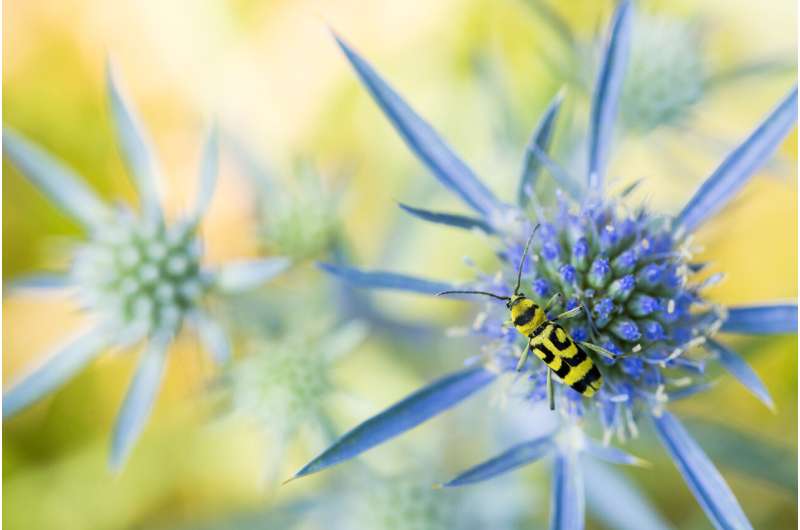This article has been reviewed according to Science X's editorial process and policies. Editors have highlighted the following attributes while ensuring the content's credibility:
fact-checked
peer-reviewed publication
trusted source
proofread
Weather conditions explain the decline and rise of insect biomass over 34 years

Insects react sensitively when temperature and precipitation deviate from the long-term average. In an unusually dry and warm winter, their survival probabilities are reduced; in a wet and cold spring, hatching success is impaired. A cool, wet summer hampers bumblebees and other flying insects to reproduce and forage.
If several such weather anomalies occur in combination and over several years, this can lead to a decline in insect biomass on a large scale and in the long term. This is shown in a report in the journal Nature.
According to the report, weather conditions and accumulations of unfavorable weather anomalies in the course of climate change can be important drivers of global insect decline. Only insect populations with a large number of individuals, as found in sufficiently large and high-quality habitats, appear to be able to survive under such adverse conditions.
Because of these new findings, the authors of the Nature report plead for more high-quality habitats. These are characterized by plants that are typical of near-natural habitats, by high structural richness or extensive use.
The report is from the research team of Jörg Müller (University of Würzburg and Bavarian Forest National Park) in cooperation with the TU Dresden (Sebastian Seibold) and the Berchtesgaden National Park as well as the TU Munich (Annette Menzel, Ye Yuan) and the University of Zurich (Torsten Hothorn). The researchers involved are jointly searching for new insights and counter-strategies to insect decline.
This is how the new findings came about
In the spring of 2022, Würzburg ecology professor Jörg Müller noticed that there were an astonishing number of insects to be found in forests and meadows. This made him wonder—after all, more and more scientific studies have been published in recent years proving that insects are declining worldwide.
The study that caused the biggest stir came from a group led by Dutch researcher Caspar A. Hallmann in 2017, in which data from the Krefeld Entomological Association was analyzed. The study revealed that the insect biomass in German nature reserves decreased by more than 75% between 1989 and 2016.
"The data from the study show that there was a dramatic collapse in 2005 and no recovery in the years that followed," says Jörg Müller, who is Professor of Animal Ecology at the Biocentre of Julius-Maximilians-Universität Würzburg (JMU). So could the large amount of insects he "felt" in 2022 be real?
In 2022, many insects were doing relatively well
Müller decided to search for the underlying causes. To do so, he built up an interdisciplinary team of researchers from TU Dresden, TU Munich and the University of Zurich.
The first task was to clarify whether there was actually much more insect biomass than usual in 2022. This was confirmed. "We found a biomass that was almost as high on average as the maximum values from the Hallmann study. And our 2022 maximum was higher than all values Hallmann had ever determined—this value, by the way, comes from the forest of the University of Würzburg," says the JMU professor.
Data from the Hallmann study re-analyzed
This observation prompted the researchers to re-analyze the data from the Hallmann study. Newly prepared weather data was incorporated, including information on temperatures and precipitation during sampling. Weather anomalies (deviations from the long-term mean) during the different phases of an insect's life—from egg to larva, pupa and adult—were also taken into account.
The scientists found that for the years from 2005 onward, weather influences were predominantly negative for insects. Sometimes the winter was too warm and dry; sometimes the spring or summer was too cold and wet. In contrast, the weather in 2022 was consistently favorable for insects, and even the previous summer was good. Consequently, this explained the relatively high insect biomass of 2022.
Consequences for the future
"We need to be much more aware that climate change is already a major driver of the decline of insect populations. This needs to be thought about much more in science and conservation practice," says Annette Menzel, professor of ecoclimatology of the Technical University of Munich.
To mitigate the extinction risk of threatened species under these conditions, more high-quality habitats are needed. Therefore, current efforts to protect insects are even more urgent than previously thought. This common task affects agriculture as well as traffic and settlement areas—in other words, all areas where high-quality habitats are reduced or impaired.
JMU professor Jörg Müller also suggests establishing a biomass monitoring system for the whole of Germany. This would make it possible to continuously measure the upward and downward trends of insect populations and include them in further analyses.
More information: Jörg Müller, Weather explains the decline and rise of insect biomass over 34 years, Nature (2023). DOI: 10.1038/s41586-023-06402-z. www.nature.com/articles/s41586-023-06402-z
Journal information: Nature
Provided by University of Würzburg




















